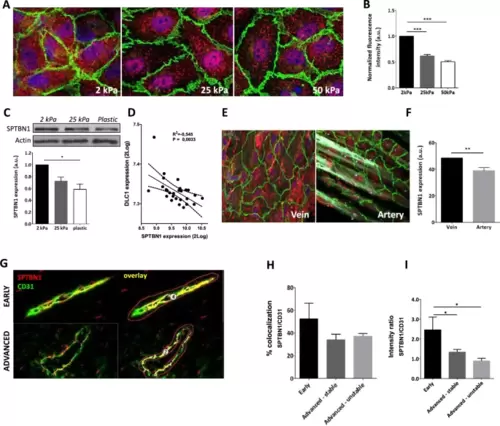Fig. 4
- ID
- ZDB-FIG-240807-12
- Publication
- Rademakers et al., 2024 - Human atherosclerotic plaque transcriptomics reveals endothelial beta-2 spectrin as a potential regulator a leaky plaque microvasculature phenotype
- Other Figures
- All Figure Page
- Back to All Figure Page
|
Increased stiffness reduced SPTBN1 protein expression both in vitro and in vivo. A HUVEC cultured on different stiffness gels showed reduced SPTBN1 protein expression by immunofluorescent staining (red). B Quantification of the IF staining showed a clear decrease in expression of SPTBN1 protein with increasing stiffness. C A similar stiffness associated reduction in SPTBN1 protein expression by endothelial cells was observed after Western Blot. D To confirm that SPTBN1 levels are stiffness dependent, the SPTBN1 expression was correlated to the stiffness sensitive marker DLC1, clearly showing reduced SPTBN1 expression upon higher stiffness. E + F To determine whether reduced SPTBN1 expression upon lower stiffness is relevant in vivo, we assessed mesenteric vein and artery from the same patient for SPTBN1 protein expression by immunofluorescence staining; a representative image is presented in E. We found that the softer vein had significantly higher endothelial expression of SPTBN1 compared to the stiffer artery (F). G–I Multispectral imaging of endothelial cells double stained for CD31 (green) and SPTBN1 (red) (G for representative images, costaining is given in yellow). Image analysis revealed a slight but not significant reduction in the level of colocalization of CD31 and SPTBN1 in microvessels in advanced vs early lesions (H), whereas relative SPTBN1 expression in plaque microvessels was significantly and progressively reduced with disease progression (I). Data are from three (A–D) or four (E, F) independent experiments or from 20 patient samples (G–I); error bars indicate SEM (B, C, D, F, H, I); *p ≤ 0.05; **p ≤ 0.01; ***p ≤ 0.005. Scalebars indicate 10µm (A and E), or 20µm (G) |

